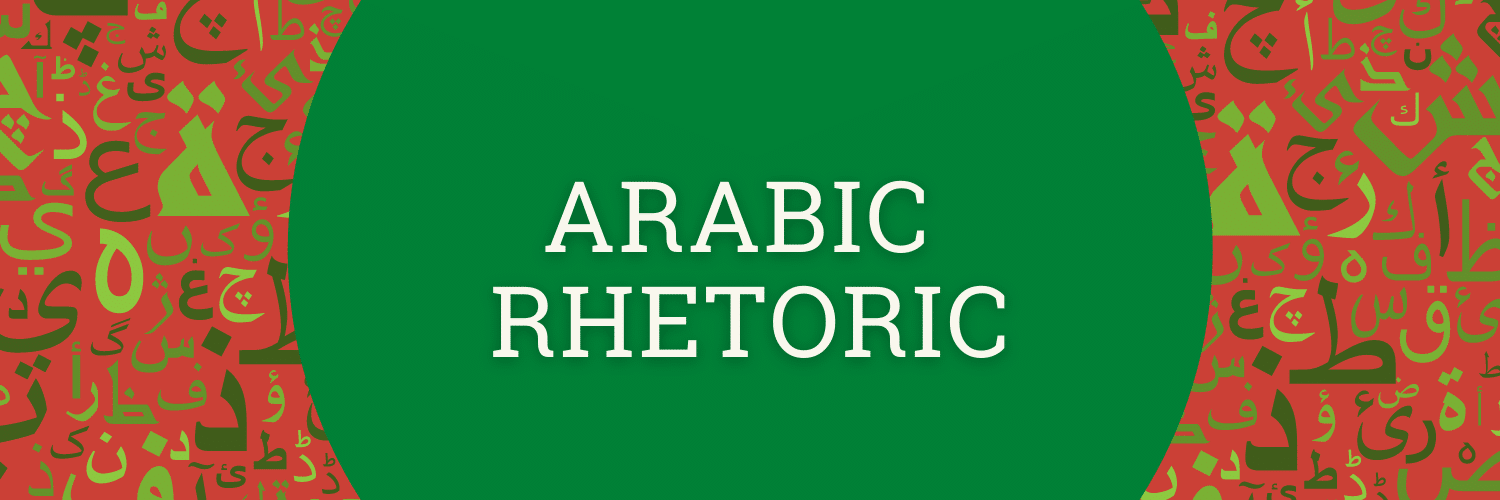Many people feel intimated by the word “rhetoric” or, in Arabic, Al Balaghah. They immediately assume it is the art of coming up with difficult words that others won’t understand. Instead, it’s the opposite. The meaning of the word “balaghah” comes from the verb لتصل
( litasil ), which means “to reach.” The idea is that the speaker communicates so the listener can understand what they are trying to explain. In English writing, they call this persuasive writing or speaking. You write or talk according to the audience you are addressing.
The word rhetoric is “the art of effective or persuasive speaking or writing, especially the use of figures of speech and other compositional techniques.” Again, the end goal is that the listener understands exactly what is being explained. The listener would be actively engaged in what the speaker is saying. Typically, a speaker of this nature would be referred to as having an eloquent tongue.
Balaghah, or rhetoric, is considered a science in the Arabic language. Therefore, it’s beneficial for every Arabic speaker to get a taste of it.
Three Areas in the Science of Balaghah
They are three areas of Balaghah. The first two make up most of it, while the last area (al budee’) is the icing on the cake or the sauce. They are as follows:
-
Science of Semantics (ilm al-ma’ani – المعاني)
– clarity of speech according to audience and context of the situation
-
Science of Expression (ilm al-bayan – البيان)
– using metaphors, similes, examples, and parables to make it relatable
-
Science of Embellishment (ilm al-budee’ – البديع)
– choice of words, tone – i.e., harsh or gentle
Transformational speech is obtained by studying and focusing on these three branches. When these three sciences are merged, it is the essence of balaghah (Arabic rhetoric).
The science of semantics is concerned with the text in its entirety. With all its meanings and with grammatical linguistic options. The science of expression is concerned with communicating the same meaning in multiple ways. It is an artistic form expressing the same idea in a thousand ways. While the last, the science of embellishment, ties everything together. It uses the bulk of Arabic rhetoric, the meaning and flow, and adds emotion to it.
Science of Semantics
Ilm al Ma’ani, or “semantics” is forming sentencing that reflects the current situation or context. It’s using grammar to address the audience in a manner that befits them. For example, if you’re speaking to children, you’ll speak in shorter sentences and use simple words.
This area of balaghah focuses on studying the entire text to achieve clarity. This is achieved through forming coherent sentences, wherein paragraphs flow together. Subject matter runs seamlessly from one idea to another without confusing the audience.
Examples of semantics in Arabic rhetoric are many: presentation and delay, separation and connection, news and creation, interrogative, elimination and remembrance, definition, and disclaimer.
An example of this in the Quran is:
“ وَاعْتَصِمُوا بِحَبْلِ اللَّهِ جَمِيعًا وَلَا تَفَرَّقُوا “
(Wa’atasimoo bihabli Allahi jamee’an wala tafarraqo)
“And hold fast, all together, by the rope which Allah (stretches out for you), and be not divided among yourselves.”
Science of Expression
The second aspect of balaghah is ilm al-bayan, which we know it as the Science of Expression. This takes on the more artistic aspect of creating eloquence.
This, of course, will also depend on the audience and within the context of present-day understanding. The goal is to display the meaning of what is said in a manner that people can relate to. An example could be “two peas in a pod.” This is an excellent way of describing like-mindedness that most native English speakers understand.
The science of expression or eloquence includes analogy; with its types: similes – an emphatic simile, a detailed/ complete simile, an overall simile, a representational simile, and an implicit simile. It also contains metaphors: mental and linguistic, declarative. A metonymy: about an adjective, the described: this also includes beautiful details, where necessary.
Science of Embellishment
The last area of balaghah or Arabic rhetoric is Ilm al-Budee’ or the Science of Embellishment. It is the icing on the cake! This element is simply the final touch and not the focus.
We need to coordinate sentences, arrange phrases, and even arrange letters within words to create verbal improvements on them. The whole structure is coherent, consistent, and easy to reach (the root word of balagha) any detail of it without minimal effort.
Examples of this include muqalalah ( interviewing), counterfeiting, and puns.
Verbal improvements in the science of ilm al-budee’ is amazing! You’ll see this in types of anagrams, assonance, division, inflection, and more.
An example in the Quran of verbal budee’ is:
“فَأَمَّا الْيَتِيمَ فَلَا تَقْهَرْ * وَأَمَّا السَّائِلَ فَلَا تَنْهَرْ”.
“Fa’ammā l-Yatīma Falā Taqhar* Wa ‘Ammā s-Sā’ila Falā Tanhar”
“So as for the orphan then (do) not oppress* And as for him who asks then (do) not repel.”
Learning the science of Al Balaghah, or Arabic Rhetoric opens the doors to truly understanding the linguistic miracle of the Quran. The layers of knowledge within the Quran are mind-blowing. At IQRA, we aim to teach all aspects of the Quran. We’ve designed our courses for all levels so that the process of attaining knowledge is easy for everyone.
IQRA’s curricula and professional learning-teaching process have been supervised by professors specializing in Arabic language sciences. They have graduated from renowned universities, such as Al-Azhar University.




